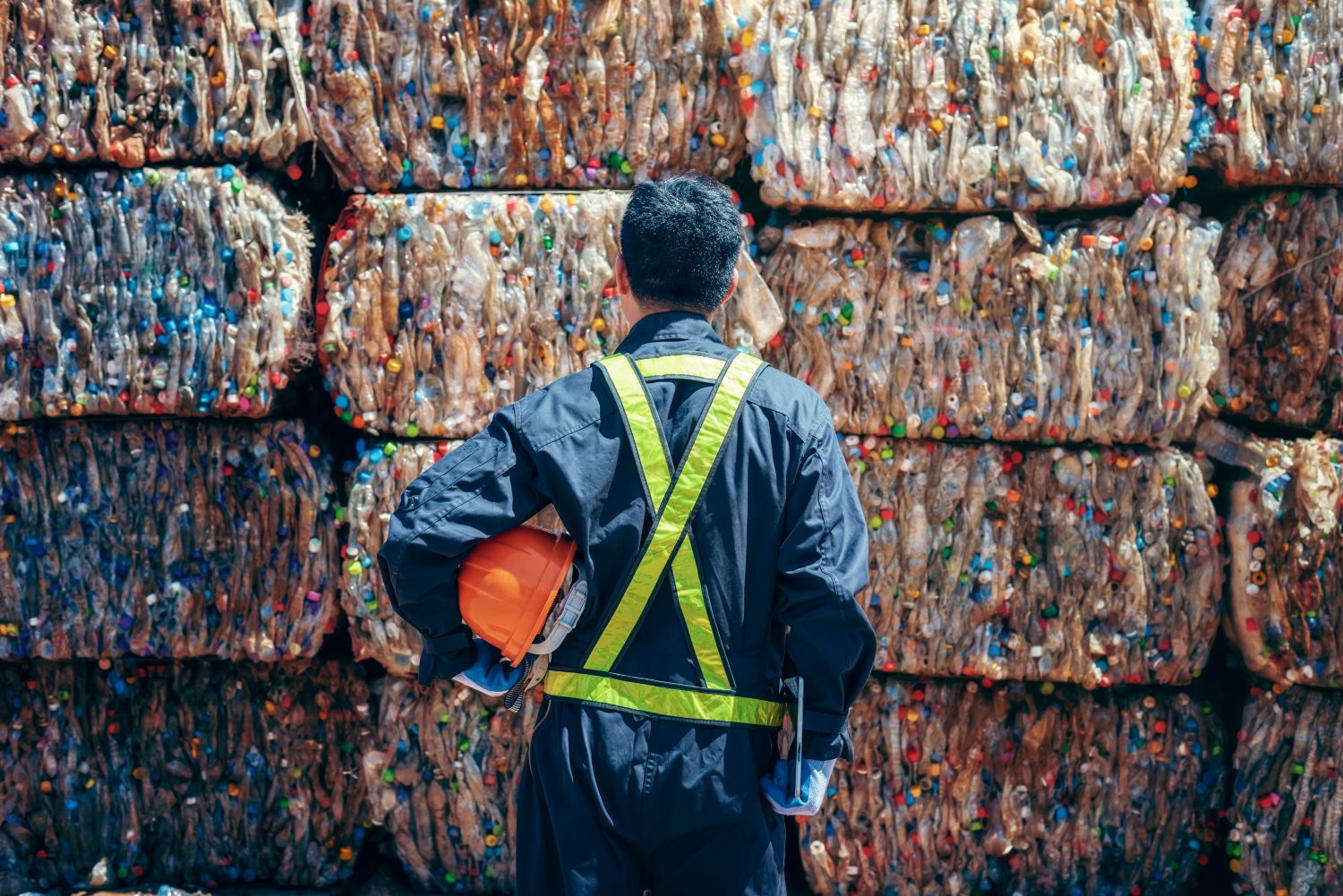The recycling bin sits at the end of the driveway in Stratford, Ontario, Canada – blue and hopeful under the morning sun. Inside, a jumble of plastic containers – water bottles, yogurt cups, the clamshell that once held local strawberries from the St. Lawrence Market – await their promised resurrection. I place them curbside, believing in this small ritual of environmental salvation, which I have carried out for four decades. It makes me feel good about my consumption.
Well, it used to.
This same act of faith is performed weekly by responsible citizens across neighbourhoods stretching from Portland to Paris, from Stockholm to Sydney.
But the truth, if we can bear to look at it directly, is that most of these carefully sorted items are embarking not on a journey of renewal, but of displacement, deception, and eventual disgrace.
The numbers don’t lie
I know this truth too well. As a sustainability professor, I stand before students weekly, extolling the virtues of environmental stewardship while a nagging dissonance echoes beneath my carefully prepared lectures. The recycling symbols displayed proudly on our campus bins – part of the broader, much-advertised “Zero Waste Initiative” – have begun to look less like arrows chasing renewal and more like a snake eating its own tail.
In a vast sorting facility at the edge of Toronto, where recycling trucks empty their hopeful cargo, Danielle has worked for nine years sorting plastics. Her hands, protected by thick gloves wearing thin at the fingertips, move with practiced precision along the conveyor belt. “The people, they think everything with the triangle goes to make new things,” she tells me during her break, a brief respite from the mechanical roar and the sweet-sour smell of food residue. “But we know. Most of it goes there.” She points to a compactor preparing bales for landfill.
Danielle is not revealing a local anomaly but confirming what researchers have documented with increasing alarm. Of the 8.3 billion tonnes of plastic manufactured since the material’s wide adoption in the 1950s, only 9% globally has been recycled. This statistic is not merely disappointing — it is an indictment of a system designed more as a pacifier for psychological comfort than practical effect.
In green, clean, and lean Canada, the numbers are equally troubling. According to Environment and Climate Change Canada, only 9% of plastic waste is recycled domestically, with 86% ending up in landfills. The remaining 4% is burned for energy, and 1% leaks into the environment as pollution. These figures persist despite Canada’s introduction of a new standard designed to harmonize recycling programs across provinces.
The recyclability myth
On a snow-dusted afternoon in Vancouver, I meet an environmental scientist who has studied Canada’s plastic waste streams for over a decade. We sit in a café where the straws are paper and the to-go containers compostable – small gestures toward a plastic-free future that seem both admirable and inadequate given what is to be shared.
“We have created a narrative that enables continued consumption,” he says, stirring his tea with apparent resignation. “The recycling symbol is one of the most successful pieces of environmental marketing ever created, and also one of the most misleading.” Guilt-free consumption. Marketing success. Check.
He speaks with the measured precision of a scientist with an undercurrent of what can only be described as controlled grief. He has spent his career quantifying what most of us prefer not to see – that the vast majority of plastic ever created still exists in some form on our planet and will continue to exist long after we are gone.
Outside the window, traffic moves through the slush, each car sealed against the fading Canadian winter with components that contain dozens of different plastic compounds, virtually none of which will be recycled in a meaningful sense.
“The new Canadian recycling standard,” he explains, referencing the government’s recent initiatives, “is well-intentioned but fundamentally flawed. It harmonizes a broken system rather than reimagining it.”
I visited an elementary school in Kitchener last year during “Earth Week,” where eight-year-olds created art from plastic waste and learn about recycling’s power to save the planet. Their teacher, beaming as they sort colourful bottle caps into different containers, proclaimed with evident pride, “We’re teaching them to be good stewards of the Earth.”
I wanted to tell her that these children are being indoctrinated into a system of manufactured virtue, that the recycling gospel they are absorbing with such enthusiasm is built on foundations of silt. Instead, I smiled and commended her dedication. The cognitive dissonance is physically painful – the same discomfort I feel when my college unveils its latest sustainability initiative with great fanfare while continuing to serve meals in single-use plastics that will never be recycled despite bearing the chasing-arrows symbol.
In my office, I review the curriculum materials provided to schools by various “environmental education” programs. Many are funded by the same corporations that produce the plastic in the first place. They teach children that the responsibility for solving plastic pollution lies in their small hands and their careful sorting, not in the production decisions made in corporate boardrooms. The externalization of costs and responsibility is masterful. Not a compliment.
The downcycling dilemma
In Richmond, British Columbia, the basement office of a former Environment Canada scientist is lined with samples of plastic in various states of degradation. There are micro-plastic fragments collected from beaches in Haida Gwaii, pellets from processing facilities, and swatches of synthetic fabric that release invisible plastic fibres with each wash. There are thousands of nano-plastics for every micro one, but we cannot see them, so they do not count.
“The industry created a system that couldn’t possibly work at scale,” he explains, holding up what appears to be a perfectly ordinary water bottle. “This PET bottle might actually get recycled. But this lid?” He removes the cap. “Different plastic. This label?” He peels off the branding. “Different plastic with adhesive contamination. The recycling symbol appears on all three components.”
Contaminated plastic cannot be reused. No contaminants are washed away. It’s logistically impossible and economically unfeasible. The scientist’s critique echoes findings from Oceana Canada’s 2022 Report, which found that many items displaying recycling symbols are, in practice, extremely difficult or impossible to recycle in most Canadian municipalities. In most municipalities everywhere, in fact.
“We’ve been sorting our trash with religious devotion,” he says, “but the system was never built to handle what we put into it.”
The truth echoes in the findings from Greenpeace’s 2020 “Circular Claims Fall Flat” Report, which concluded that only PET (#1) and HDPE (#2) bottles and jugs have significant recycling markets in the United States – representing less than 5% of all plastic produced. Add to this challenge – total plastic recycling in the United States has plunged to 5%.
This is the crux of my personal angst as a sustainability educator. I teach students about systems thinking and environmental responsibility while participating in a collective fiction of Kafkaesque proportions. My college proudly displays its sustainability awards in the same building in which I watch custodians empty carefully sorted recycling bins into the same waste stream as general garbage after public events – a practice I have been told is necessary due to the aforementioned “contamination issues.” The bins have one bag, but three chutes. Where they have discrete chutes, they end up in the same place. It is all theatre.
The export problem
Dawn breaks cold and clear over Malaysia’s Selangor State, where a colleague walks me through what was once her family’s palm plantation. Today, scattered among the remaining trees are hills of plastic waste – shipped thousands of miles from North American recycling programs before the practice was banned in 2022.
“After China closed its doors to the world’s plastic in 2018, it came here,” she says, gesturing toward a hillside strewn with faded Tide bottles, fragmenting food containers, and tangles of plastic film. “They told us it would bring jobs. They didn’t say it would bring this.” Waste plastic exports into Malaysia surged a stunning 35% in one year between 2022 to 2023, calling into question the ethics of European Union plastic recycling. It is lucrative business, for some in the chain from Brussels to here.
What “this” is – beyond the immediately visible blight – is revealed in a 2022 study by the Basel Action Network (BAN) that tracked plastic waste exports. It found that significant quantities of supposedly “recyclable” materials were ending up in unregulated dumps across Southeast Asia. The researchers embedded tracking devices in bales of plastic from Canadian recycling facilities and followed them to their final destinations – often illegal dump sites or makeshift processing facilities with minimal environmental controls. My neighbour tracked his recycling in November 2024 just for kicks – the GPS tracker eventually lost signal outside of Montreal on the St. Lawrence River. A 2018 Science Advances study estimated from 20-70% of plastic waste exported for recycling ends up in landfills, illegal dumpsites, or the environment in countries with limited regulatory oversight. “Limited” is the academically polite word for effectively “none.”
Agreed-upon rules are being ignored. Among the 2021 trade data (Comtrade) findings presented by organizations BAN and Break Free From Plastic:
- The European Union decided unilaterally to simply not enforce the Basel Rules for trade between member states.
- Canada similarly decided to ignore the rules for their plastic waste trade with the U.S.
- Japan is the world’s leading exporter of plastic waste to weaker economies.
- The U.S. is the second-largest exporting country and has recently begun dramatically increasing their exports to Mexico.
- The Netherlands has become a conduit for exporting European plastic waste to Asia.
- The UK is shifting its exports from Turkey to Asia via the Netherlands.
- The U.S. and EU illegally exported approximately 20,500 containers of PVC plastic waste last year.
In the distance, black smoke rises from an improvised processing operation where workers without protective equipment burn plastic to recover metal components. The air carries a sharp, chemical edge that catches in the throat.
“The plastic comes with the symbol,” she says, picking up a bottle and pointing to the chasing arrows that have become the hieroglyph of our absolution. “But the symbol doesn’t mean anything here.”
The corporate responsibility gap
Back in downtown Toronto, in gleaming corporate headquarters that shall remain nameless, I meet with an executive who oversees sustainability initiatives for one of the country’s largest producers of consumer plastics.
The walls of the visitor center celebrate the company’s recycling investments and commitments to ocean conservation. What they do not mention is revealed in a 2023 report by Environmental Defence Canada, “Left Holding the Bag” that found that plastic production in the country is slated to increase by 30% over the next decade despite federal pledges to tackle plastic pollution. Ouroborus, indeed.
“We believe in the circular economy,” the executive tells me, gesturing toward a display showing how plastic can theoretically be recycled over and over again. The model does not account for the degradation that polymer chains break down during each recycling cycle. The molecular integrity in plastic is less durable than touted. Infinite recycling is a card trick, though promising research aims to crack that nut.
When I mention this research, there is a brief pause in our carefully choreographed tour. “We are investing in advanced recycling technologies,” she says, before guiding me toward a different exhibit to showcase accomplishments. Her smile is beautiful. Her business is not.
This is the beautiful deception in its most refined form – the corporate embrace of a soothing narrative that allows business as usual to continue beneath a veneer of environmental concern and governments marrying virtue to new taxes and fees – a throuple of infidelity. I recognize it because I participate in my own version of this performance every day in academia, where sustainability reports filled with aspirational language avoid the uncomfortable truths about our institutional practices.
Moving beyond the recycling myth
Each semester, I face a new cohort of eager students who believe in the power of recycling with religious fervour. They have been taught since kindergarten that the blue bin is their personal contribution to saving the planet. I struggle with how much truth to share; how much disillusionment is productive versus paralyzing.
I recently asked a class of first-year environmental studies students how many believed that most plastic placed in recycling bins actually gets recycled. Nearly every hand went up. When I shared the actual statistics – that despite decadal, highly publicized recycling standards and governments’ pledges to achieve zero plastic waste by 2030, the vast majority of our plastic still ends up in landfills or the environment. Their faces register shock, then disbelief, then some hybrid of confusion and betrayal.
“But why do they tell us to recycle it then?” one student asked, her voice carrying the unmistakable edge of someone confronting a lifetime of well-intentioned misdirection.
Indeed. Why do we?
The truth about plastic recycling is not hidden in classified documents or secret meetings. It lives in plain sight, in publicly available studies and market reports, in warehouses and processing facilities, and backyard waste piles across the globe. It exists in the growing body of evidence that suggests we have built an elaborate system of management around a problem that cannot in any way be managed or reduced.
As I leave campus one spring morning, the parking lot is silent under the blizzard’s fresh snow. Near my car, a plastic water bottle sits frozen in place, its recycling symbol just visible above the white surface – a tiny promise trapped in ice, going nowhere at all. In its stillness, I see a reflection of our collective paralysis – knowing the truth but unable to act upon it in any meaningful way.
Last week, I closed the semester with a riff about sustainability. And I will continue to wrestle with how to reconcile the truth with the theatre of environmental virtue that surrounds us, from Puerto Toro to Alert, from Tokyo to Rio, and all the hopeful blue bins in between, dutifully filled, emotionally satisfied.
















